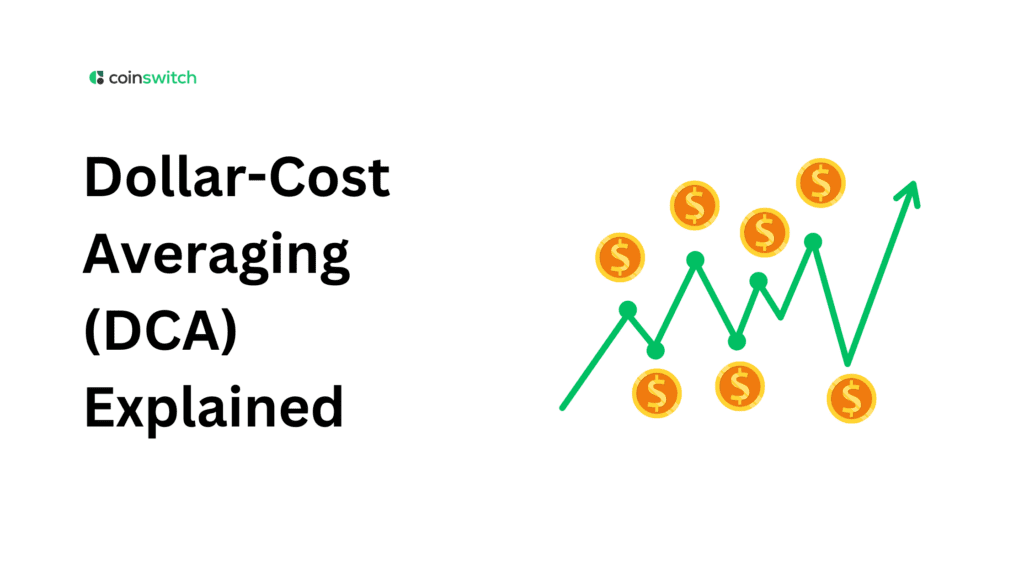DCA, which stands for dollar-cost averaging, is a simple but effective investment strategy. It reduces the risks for buyers who try to time the market. Here, you invest a set amount at regular intervals, rather than a large sum all at once. These intervals can be once a week, once a month, or three times a year. The key is to remain consistent, even if market prices fluctuate.
Thus, investors can lower their average cost per share. DCA also mitigates the impact of market fluctuations. It encourages people to invest regularly, which fosters discipline over time. This takes away the worry of trying to guess when the best time to buy is. Essentially, dollar-cost averaging helps your investment grow over time while reducing the number of emotional choices you have to make. Let’s understand in detail what is DCA.
What Is Dollar-Cost Averaging?
Dollar-cost averaging is a method of investing money where the same amount is invested in different assets at regular intervals. It doesn’t matter whether the market is going up or down; the amount stays the same. This method makes you more disciplined and removes emotion from your investment choices.
For instance, if you spend $100 every month, the process will continue even if the market is down. If the price is high, $100 will only get you a few shares. The same $100 will buy more shares when prices are low. This helps bring down the average cost per share over time. It also makes it less likely that you’ll invest at the wrong time. You don’t try to time the market; instead, you focus on being consistent. Investing in this way is less stressful and better for long-term progress.
How It Works
Though it depends on your situation, DCA helps people make money over time. You should decide when to buy based on how the market is doing, or you can just buy regularly over time and use the dollar-cost average method.
One should use dollar-cost averaging because you invest what you can as soon as it becomes available.
How to Dollar-Cost Average?
You can do DCA manually or automatically, whichever you prefer. When you use the manual method, you set aside a fixed amount of money at regular intervals, such as every month or every two weeks. Setting up the automatic way ensures uniformity without constant monitoring.
Choose What to Invest In
You need to choose what you want to buy first. This could be a stock, an ETF, or a joint fund. Stocks are riskier than broad funds because their values can fluctuate significantly. ETFs and mutual funds give you a wider view of the market and lower your risk. Funds based on averages, such as the S&P 500, are often better suited for new buyers.
Talk to Your Broker
Once you’ve chosen an investment, check with your broker to see if they offer automatic buy plans. Some companies only allow you to do this with mutual funds, which limits your options. You might want to open a new account if your current broker doesn’t meet your needs. Having more than one account can also give you access to more tools.
Schedule Your Automatic Plan
Lastly, use the amount and regularity to set up a routine for your plan with your broker. The steps are a little different for each platform, but the general idea is the same. You might want to reinvest the dividends from your investment. With this investment, dividends can instantly buy more shares.
Read More: Day Trading: The Basics and How to Get Started
Benefits
Now that you know what is DCA, you should understand that when investors use dollar-cost averaging, they can build wealth over time in a steady and organized way. Making a promise to invest regularly, regardless of market fluctuations, helps manage risks, keep emotions in check, and promote consistency. Here are some key benefits:
Lowers the Risks of Market Timing
Even for pros, trying to time the market is tough. This stress is reduced by dollar-cost averaging, which involves making regular investments. You don’t have to worry about high or low prices because you’re making regular investments, regardless of price levels. This makes it less likely that you’ll buy something at the wrong time.
Evens out Market Volatility
Markets are constantly fluctuating, and your predictions are often inaccurate. When investing in different markets at different times, dollar-cost averaging enables you to spread out your money. When prices go down, you buy more shares, and when they go up, you sell some. This lessens the impact of short-term changes over time. Instead, steadily adding to your wealth will keep it on track.
Helps with Discipline
Being disciplined is one of the best things about DCA. By committing to regular purchases, you establish a habit of managing your finances effectively. This keeps you focused on your long-term goals, helping you avoid short-term noise. You don’t second-guess choices or stop because you’re afraid. The steady focus pays off in the long run, resulting in better financial outcomes.
Read More: What is Momentum Trading?
Whom is it meant for?
DCA is a careful way to deal with market fluctuations and build wealth over time. With dollar-cost averaging, investors who plan to hold on to their investments for a long time can save money over time.
People who use this method usually don’t have a lot of money to spend all at once. They get by putting any extra money they have into their portfolio every week or month. Having said that, dollar-cost averaging might also be appealing to new buyers who are unsure about when to buy an investment.
Timing the market is one of the hardest things for buyers to do, and not even professionals are good at it. Many people wish to spend but don’t do it because they are afraid of the risk or make the wrong choice and lose money. With dollar-cost averaging, you don’t have to worry about making this choice.
Special Considerations
If you want to buy a stock over a specific period of time while the price is fluctuating, dollar-cost averaging is a good way to do it. People who use DCA will buy fewer shares if the price continues to rise. If the price continues to drop, they might continue buying when they should be waiting.
This means that the plan can’t protect buyers from the risk that market prices will decline. The plan thinks that prices will rise in the long run, even if they fall sometimes. Additionally, using this method to buy a single stock without first learning about the company could be harmful. The reason for this is that an owner may keep buying stock even though they normally would stop or sell.
When used to buy index funds instead of individual stocks, the approach is significantly less risky for buyers who lack in-depth knowledge. When investors use dollar-cost averaging, their cost basis in a stock typically decreases over time. With a lower cost base, investments that go down in value will lose less money, and investments that go up in value will win more.
Example
For instance, you want to buy XYZ stock but don’t want to put all of your money into it at once. You could instead put away a set amount, say $300 a month. Assuming the stock is worth $10 each month, you will buy 30 shares. In the end, you will buy 25 shares that month if it goes up to $12. You’ll get 37 shares if the price drops to $8 in a month. Long-term, if you stick to this plan, you’ll put the same amount of money into the same stocks every month, which will reduce the impact of market fluctuations.
Conclusion
DCA, or dollar-cost averaging, is a technique that has its pros and cons. It’s suitable for buyers who want to take less risk.
Still, buying all at once may work better during long bull markets. DCA can be used in conjunction with asset selection and diversification by investors. Regularly adjusting your portfolio can enhance your financial returns even further.
FAQs
1. What does DCA do?
Dollar-Cost Averaging (DCA) is a method of investing where you invest the same amount of money every month, regardless of market performance. It lowers the chances of timing the market and riding out volatility.
2. Is DCA a good strategy?
DCA is a great way for new investors to begin because it helps them avoid the risk of trying to time the market. It’s also beneficial for long-term investment goals, as it allows you to relax and let the money grow without needing to monitor the market constantly.
3. How does DCA work in crypto?
DCA is a method for spending a set amount of money in crypto regularly, regardless of the price. Using average buy prices, this method evens out market fluctuations. It helps new investors and long-term investors stay disciplined and doesn’t require them to time the market.
4. What is the average cost of DCA?
The average cost in DCA is the total amount of money spent divided by the total number of units bought. Over time, this makes a weighted average price. DCA often lowers overall costs in uncertain markets by buying more when prices are low and less when prices are high.








